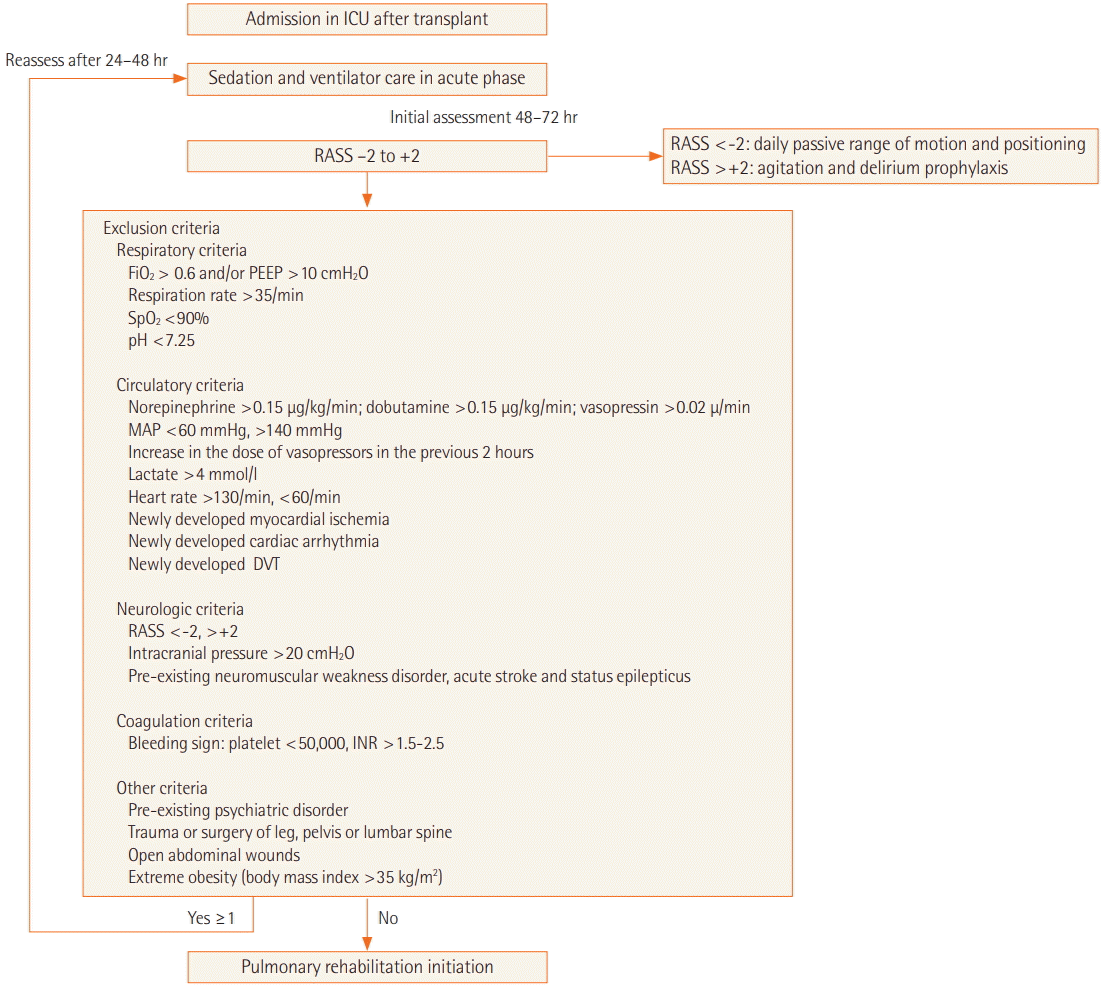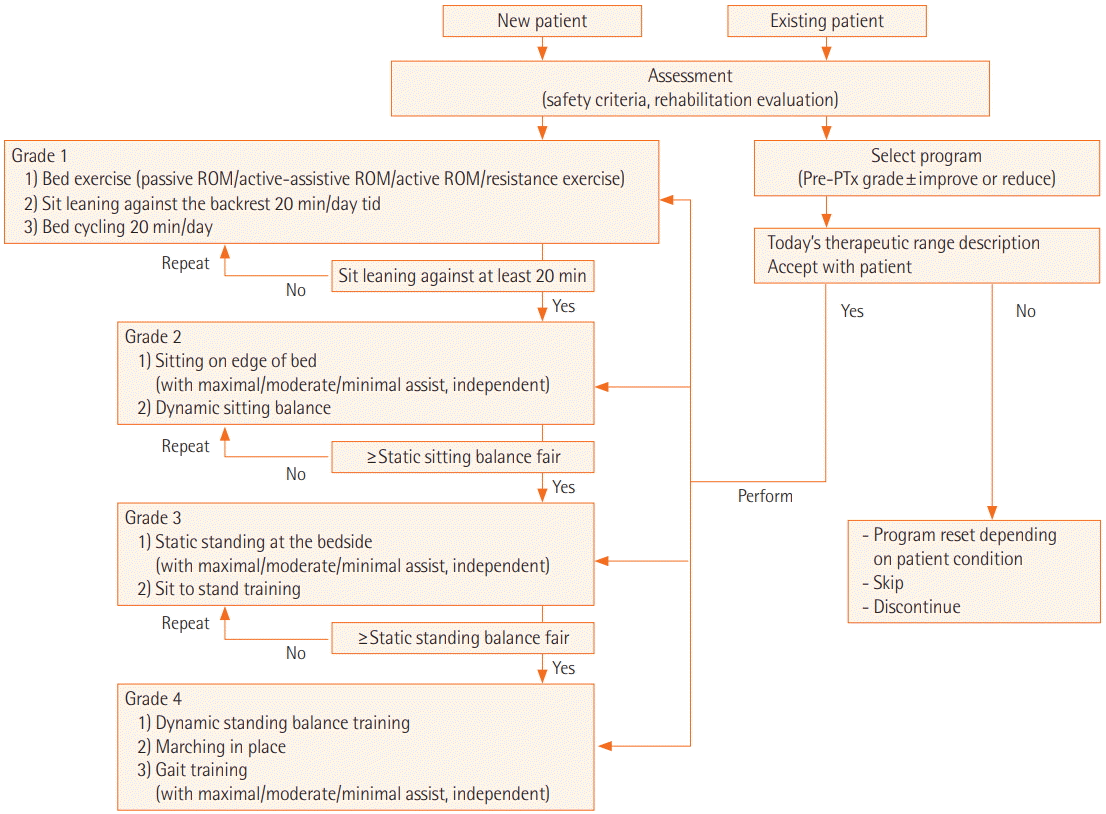INTRODUCTION
MATERIALS AND METHODS
Study Design and Patients
 | Figure 1.Assessment of eligibility for pulmonary rehabilitation. ICU: intensive care unit; RASS: Richmond Agitation-Sedation Scale; FiO2: fraction of inspired oxygen; PEEP: positive end-expiratory pressure; SpO2: peripheral oxygen saturation; MAP: mean arterial pressure; DVT: deep vein thrombosis; INR: international normalized ratio. |
Pulmonary Rehabilitation Program
Statistical Analysis
RESULTS
Patient Characteristics Prior to PR in the ICU
Table 1.
| Characteristics | Value |
|---|---|
| Age (yr) | 52.6±12.4 (25-73) |
| Male sex | 14 (64) |
| Body mass index (kg/m2) | 19.9 (16.25-23.4) |
| Smoker | 13 (59) |
| Underlying lung disease | |
| IPF | 12 (54) |
| COPD | 1 (5) |
| PPAH | 1 (5) |
| AIP | 2 (9) |
| Bronchiectasis | 2 (9) |
| Post-SCT BOS | 3 (13) |
| CVD-ILD | 1 (5) |
| mMRC grade | |
| II or III/IV | 9 (41)/13 (59) |
| NYHA grade | |
| II or III/IV | 7 (32)/15 (68) |
| Comorbidity | 10 (45) |
| Osteopenia/osteoporosis | 7 (32)/5 (23) |
| 25-Hydroxy vitamin D (ng/ml) | 9.0 (6.1-19.0) |
| Pulmonary function | |
| FVC (l) | 1.5 (1.1-2.4) |
| FEV1 (l) | 1.1 (0.8-1.9) |
| FEV1 (% predicted) | 43 (30-62) |
| Cardiac function | |
| LVEF (%) | 64 (58-68) |
| Emergency statusa | |
| Status 0 | 10 (45.5) |
| Status 1 | 11 (50) |
| Status 2 | 1 (4.5) |
| Time on waiting list (day) | 35 (10-168) |
| Donor age (yr) | 42.2±12.9 (16-59) |
| Donor sex, male | 15 (68) |
| Donor body mass index (kg/m2) | 22.8 (15.8-32) |
| Donor PaO2/FiO2 | 428 (195-669) |
| Preoperative status | |
| Tracheostomy | 6 (27) |
| Hospitalization | 3 (14) |
| ICU care | 11 (50) |
| Mechanical ventilator | 11 (50) |
| ECMO support | 7 (32) |
Values are presented as mean±standard deviation (range), number (%), or median (interquartile range).
IPF: idiopathic pulmonary fibrosis; COPD: chronic obstructive pulmonary disease; PPAH: primary pulmonary hypertension; AIP: acute interstitial pneumonia; SCT: stem cell transplantation; BOS: bronchiolitis obliterans syndrome; CVD-ILD: collagen vascular disease related interstitial lung disease; mMRC: modified Medical Research Council; NYHA: New York Heart Association; FVC: forced vital capacity; FEV1: forced expiratory volume in 1 second; LVEF: left ventricular ejection fraction; PaO2: arterial partial pressure of oxygen; FiO2: fraction of inspired oxygen; ICU: intensive care unit; ECMO: extracorporeal membrane oxygenation.
Physical Function Assessed by Mobilizing Capacity
Table 2.
| Patient no. | Age (yr) | Sex | Diagnosis | Start of PR | Days of PR | Initial functional grade | Best functional grade | Final functional grade | O2 support at start of PR | O2 support at finish of PR | Status, survival months | Outcome (cause of death) |
|---|---|---|---|---|---|---|---|---|---|---|---|---|
| 1 | 54 | F | CVD-ILD | POD 14 | 10 | 4-2 | 4-3 | 4-3 | Nasal | Nasal | Alive, 14.8 | - |
| 2 | 63 | M | IPF | POD 7 | 48 | 2-1 | 4-2 | 4-2 | HFNC | Nasal | Alive, 16.0 | - |
| 3 | 46 | F | Bronchiectasis | POD 11 | 27 | 3-2 | 4-3 | 4-3 | Ventilator | Room air | Alive, 15.7 | - |
| 4a | 52 | M | IPF | POD 7 | 13 | 2-1 | 1-1 | 1-1 | T-mask | Ventilator | Died, 1.4 | Sudden cardiac arrest |
| 5 | 49 | F | AIP | POD 1 | 59 | 1-1 | 1-1 | 1-1 | Ventilator | Ventilator | Died, 2.9 | Bleeding |
| 6 | 32 | F | Post-SCT BOS | POD 8 | 217 | 3-1 | 4-2 | 4-2 | Ventilator | Room air | Alive, 14.6 | - |
| 7 | 62 | F | Bronchiectasis | POD 6 | 103 | 1-2 | 1-1 | 1-1 | Ventilator | Ventilator | Died, 4.0 | Pneumonia (Pseudomonas aeruginosa) |
| 8 | 26 | M | Post-SCT BOS | POD 6 | 85 | 1-2 | 3-2 | 3-2 | Nasal | Room air | Died, 12.7 | Sepsis (Acinetobacter baumannii) |
| 9 | 58 | F | IPF | POD 12 | 5 | 3-3 | 4-2 | 4-2 | Ventilator | Nasal | Died, 5.4 | Thrombotic thrombocytopenic purpura |
| 10 | 73 | M | IPF | POD 7 | 26 | 2-1 | 4-3 | 4-3 | Nasal | Room air | Died, 10.3 | Pneumonia (A. baumannii) |
| 11 | 58 | M | IPF | POD 1 | 14 | 1-1 | 4-2 | 4-2 | Nasal | Nasal | Died, 6.5 | Pneumonia (pathogen unknown) |
| 12 | 64 | M | IPF | POD 6 | 42 | 1-2 | 4-3 | 4-3 | Nasal | Room air | Alive, 13.4 | - |
| 13 | 60 | M | IPF | POD 6 | 59 | 1-2 | 3-1 | 3-1 | Ventilator | Ventilator | Died, 4.9 | Sepsis (A. baumannii) |
| 14 | 61 | M | COPD | POD 7 | 10 | 2-1 | 4-1 | 4-1 | Nasal | Nasal | Died, 5.6 | Pneumonia (A. baumannii) |
| 15 | 61 | M | IPF | POD 7 | 5 | 2-1 | 1-1 | 1-1 | Ventilator | Ventilator | Died, 1.5 | Sepsis (pathogen unknown) |
| 16 | 46 | M | AIP | POD 6 | 8 | 1-2 | 1-1 | 1-1 | Ventilator | Ventilator | Died, 2.6 | Sepsis (pathogen unknown) |
| 17 | 55 | F | IPF | POD 13 | 7 | 4-1 | 4-3 | 4-3 | Nasal | Nasal | Alive, 10.6 | - |
| 18 | 53 | M | IPF | POD 1 | 27 | 1-1 | 4-3 | 4-3 | Ventilator | Room air | Alive, 10.1 | - |
| 19 | 41 | M | Post-SCT BOS | POD 7 | 75 | 2-1 | 4-3 | 4-2 | Ventilator | Nasal | Alive, 9.4 | - |
| 20 | 25 | F | PPHN | POD 6 | 43 | 1-2 | 1-2 | 1-2 | Ventilator | Ventilator | Died, 2.3 | Sepsis (A. baumannii) |
| 21 | 60 | M | IPF | POD 7 | 42 | 2-1 | 4-3 | 4-3 | Nasal | Room air | Died, 5.5 | Sepsis |
| 22 | 58 | M | IPF | POD 8 | 10 | 3-1 | 4-3 | 4-3 | Nasal | Nasal | Alive, 7.0 | - |
PR: pulmonary rehabilitation; CVD-ILD: collagen vascular disease related interstitial lung disease; POD: postoperative day; IPF: idiopathic pulmonary fibrosis; HFNC: high flow nasal cannula; AIP: acute interstitial pneumonia; SCT: stem cell transplantation; BOS: bronchiolitis obliterans syndrome; COPD: chronic obstructive pulmonary disease; PPHN: primary pulmonary hypertension.




 PDF
PDF Citation
Citation Print
Print




 XML Download
XML Download